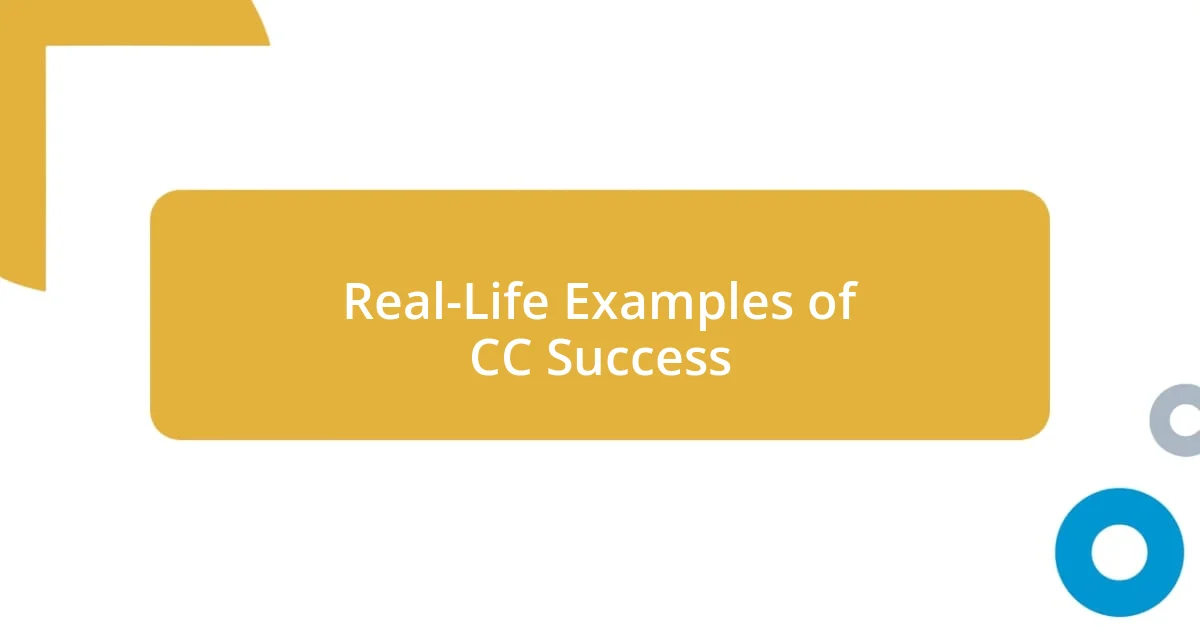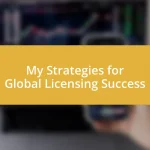Key takeaways:
- Creative Commons licenses empower creators to share their work while retaining certain rights, fostering collaboration and visibility.
- The choice of a specific license (e.g., Attribution, NonCommercial) significantly impacts how others can use and interact with your creations.
- Real-life examples illustrate the transformative potential of CC licensing, enhancing opportunities for exposure, collaboration, and community enrichment.

Understanding Creative Commons Licensing
Creative Commons licensing is a fascinating way for creators to share their work while retaining some rights. When I first discovered it, I felt a sense of relief—finally, a legal framework that allows us to collaborate without fear of infringement. Isn’t it empowering to know that you can give others permission to use your art, as long as they credit you?
There are various types of Creative Commons licenses, each tailored to different levels of openness. For instance, I often opt for the Attribution-NonCommercial license because it allows others to share my work as long as they aren’t profiting from it. Have you ever considered how your work could be appreciated in more ways if you provided this freedom? It’s eye-opening to think about how sharing can lead to more visibility and connections in creative communities.
Choosing the right license can feel daunting, but it’s all about understanding what you want to achieve. I remember spending hours deliberating over which license to use for my photos, wanting to protect my rights while also fostering creativity. Have you found yourself in a similar position? The beauty of Creative Commons lies in its flexibility—once you find that perfect fit, it can open doors you didn’t even know existed.

Benefits of Creative Commons Licenses
The benefits of Creative Commons licenses are truly remarkable. One of the standout advantages for me has been the increased exposure and collaboration opportunities. When I decided to use a Creative Commons license for my music, I found that more people were willing to share it on their platforms. This act of sharing not only brought my work to a broader audience but also created unexpected partnerships, leading to collaborative projects that I hadn’t anticipated. It’s like opening a door to a creative world I didn’t know existed.
Here’s a quick list of some benefits I’ve experienced and observed:
- Enhanced Visibility: Sharing your work openly can attract more attention.
- Collaboration Opportunities: Allows for networking and partnerships with other creators.
- Community Enrichment: Contributes to a culture of sharing and collaboration within creative circles.
- Attribution and Credit: Ensures you receive recognition for your work, building your reputation.
- Flexibility in Licensing: Offers various options to suit different needs and intentions.
I can remember the thrill of seeing my photography pop up on blogs and social media, all thanks to the license I chose. It’s incredibly rewarding to know that what I’ve created is part of a larger conversation.

Types of Creative Commons Licenses
Creative Commons licenses come in various types, each designed to cater to different creator preferences. The most common licenses include Attribution, ShareAlike, NonCommercial, and NoDerivatives. Personally, I’ve learned that each option can significantly affect how others interact with my work. For example, while the Attribution license allows for maximum freedom of use, the NonCommercial variant gives me peace of mind, ensuring that my creations aren’t being used for profit without my permission. Have you ever thought about the balance between sharing your work and maintaining control?
To provide a clearer understanding, I created a comparison table to help visualize the differences among the licenses. It’s fascinating to see how these small choices can shape one’s creative journey. Reflecting on my own experiences, I remember when I chose to implement a ShareAlike license for my writing. I wanted to encourage adaptations while ensuring that modifications would also share the same freedoms I provided. This just felt right to me, almost like paying it forward in the creative ecosystem.
The beauty of exploring these licenses is all about what resonates with your goals. As I dug deeper into Creative Commons, I found that some creators favor the NoDerivatives license due to its protective nature. It’s striking how a small detail can shift the dynamics of interaction between creators and their audiences. I often ponder on the potential conversations my work might spark through these choices and how they can foster a collaborative spirit.
| License Type | Description |
|---|---|
| Attribution (CC BY) | Allows others to use, distribute, and modify your work as long as they credit you. |
| ShareAlike (CC BY-SA) | Similar to Attribution, but derivatives must be licensed under identical terms. |
| NonCommercial (CC BY-NC) | Allows use and modification of your work for non-commercial purposes only. |
| NoDerivatives (CC BY-ND) | Allows others to use your work as-is, but not to modify it. |

Applying a Creative Commons License
When it came time to apply a Creative Commons license to my work, I dove into the process with a mix of excitement and trepidation. I remember sitting at my desk, contemplating the implications of the choices ahead—how would I want others to interact with my creations? Ultimately, I chose the Attribution license, feeling it balanced my desire for exposure with the importance of giving credit where it’s due. It’s almost like casting a spell: once you put that license out into the world, you’re inviting all kinds of engagement and use.
The actual process of applying the license was incredibly straightforward. I simply visited the Creative Commons website, selected my license type, and generated a code snippet to embed in my work. What struck me was the sense of empowerment I felt during this phase—taking ownership of my artistic rights while also opening the door for others. Have you ever experienced the thrill of sharing your work in a way that both retains your integrity and encourages others to participate? For me, this was a transformative moment, solidifying my commitment to a creative community.
Looking back on my journey, I can confidently say that the application of a Creative Commons license not only provided a framework for sharing but also served as a catalyst for growth. I recall a particular instance where my licensed music made its way into a local filmmaker’s project, leading to an unexpected collaboration. That connection might not have happened without the license! Each step I took felt like planting seeds, and watching them sprout into something beautiful has been one of the most rewarding parts of adopting this licensing approach. Isn’t it amazing how a simple choice can weave your creative journey into the larger tapestry of collaboration?

Promoting Your Work Under CC
When I started promoting my work under a Creative Commons license, I quickly discovered the power of sharing my creations with a broader audience. I remember feeling a genuine thrill when I saw my art featured on a blog that I admired, all because I had made it accessible through the Attribution license. It was a moment that highlighted how the right licensing choice can open doors and elevate visibility in unexpected ways. Have you thought about how much your work could resonate with others by just making it shareable?
Social media became my primary avenue for promotion, allowing me to showcase my Creative Commons licensed pieces to diverse communities. I made sure to use relevant hashtags and engage with audiences that appreciated open access to creative work. One of my proudest achievements was when a fellow artist reached out, eager to collaborate on a project that stemmed from sharing my CC-licensed designs. I found that my openness not only forged connections but also inspired others to explore their creative potential—how rewarding is that?
I also learned the importance of providing clear attribution when promoting my work. When I shared an article featuring my CC-licensed writing, I made it a point to encourage others to credit me properly. This practice helped reinforce my identity as an author while empowering others to share my work. It felt like creating a nurturing ecosystem where everyone benefited. Reflecting on this, I realize how essential it is to promote not just my work, but also the values of collaboration and respect in the creative community. What have you done to ensure your work is properly recognized while making it accessible?

Real-Life Examples of CC Success
One of the most inspiring examples of Creative Commons (CC) success I’ve encountered is the story of a musician who used the CC Attribution-ShareAlike license. This artist’s track went viral on platforms like SoundCloud and YouTube, mainly because creators across different genres felt free to remix and build upon the original work. Isn’t it incredible how this musician not only gained exposure but also created a rich tapestry of collaborative art that expanded their reach? I couldn’t help but marvel at how that initial decision to share openly transformed their career in such a profound way.
I also remember reading about an educational initiative that utilized CC-licensed resources to create an open-source textbook for high school students. By allowing educators to modify and share the text, the project dramatically increased accessibility to quality materials for underserved communities. It felt uplifting to see firsthand how a simple license could foster equality in education. Have you ever thought about the ripple effect one accessible resource can create in a community? This realization made me reflect on my own contributions and the larger impact they can have on society.
Then there’s the case of a photographer whose work gained international recognition after sharing it under a CC license on platforms like Flickr. This decision not only led to his photos being featured in magazines but also helped him connect with climate activists who used his images to promote awareness fighting climate change. That personal connection resonated deeply with me. It made me consider how sharing our work can spark movements or inspire change. Have you ever witnessed your creation inspire someone in a significant way? These stories remind me of the boundless potential in embracing openness and collaboration through Creative Commons.












